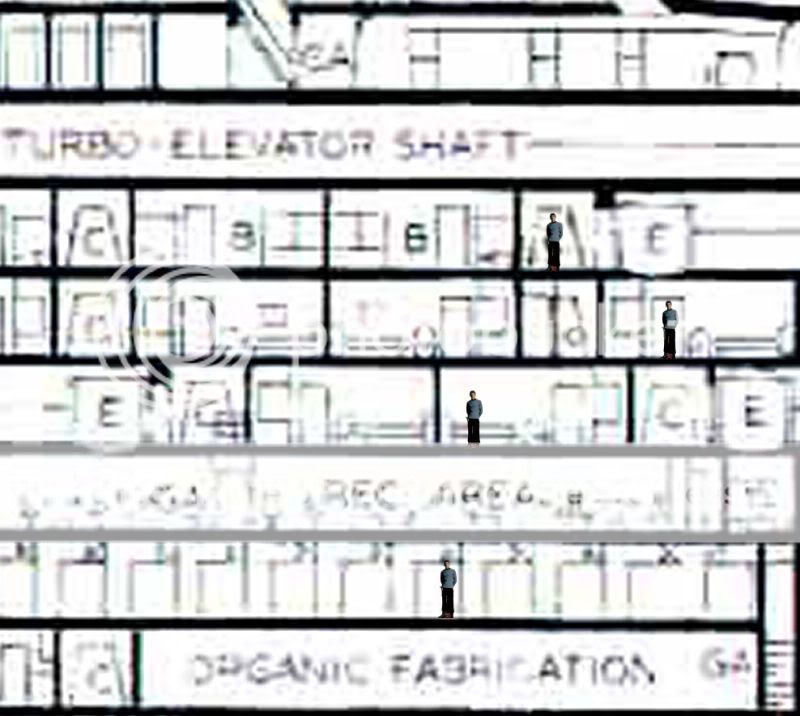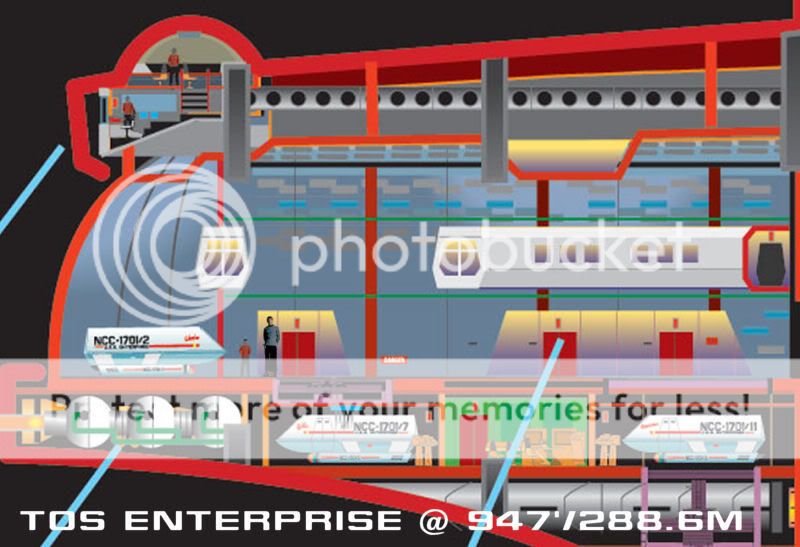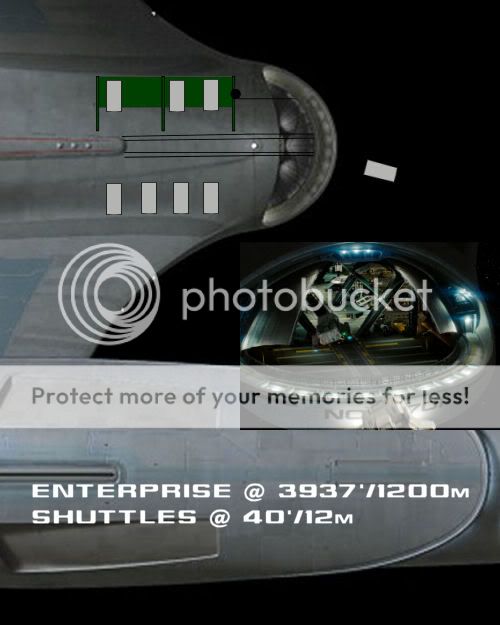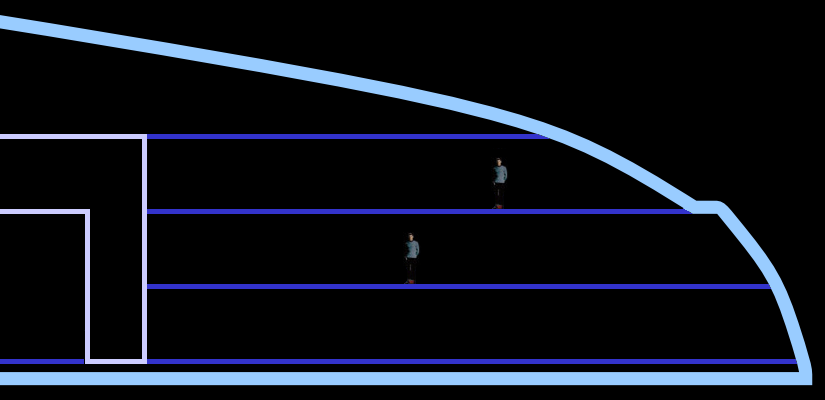As a lifelong Trek fan who used to absorb the technical manuals, fact files and diagrams, I knew that some fudging was required to make the ships work out at their supposed sizes. A corridor here (TMP engine room) an ignored hull curve (TMP Rec Deck) or nonexistant bump on the bridge module (Ent-E) there are one thing, but a few minutes in Paint Shop Pro is all it took to show me that many of these diagrams and ship sizes are blatantly inacurrate, going all the way back to the ones in The Making of Star Trek.
Spock is 6’ tall. Apologies for the poor quality of some of the pics when scaled up.
The TOS Enterprise is supposed to be 947’/288m long, with 23 decks. At that size, the bridge deck doesn’t fit facing forwards (thanks to the turbolift) and the decks have a maximum ceiling height of 8’, less than the actual sets.
Franz Joseph Schnaubelt’s blueprints rotated the bridge and simply pretended the ship has 8’ ceilings and 6’ doorframes. Doug Drexler’s cutaway (seen in “In a Mirror, Darkly”) scales up the Constitution-class to 1420.5’/433m (150%) in order to fit everything in (check out Spock at actual size vs. the “scale” redshirt!)
Matt Jefferies' original cutaway:

Franz Joseph's blueprints:

Doug Drexler's cutaway:


The Excelsior class is supposedly 467 meters long. Take a look at this scaled section of the Enterprise-B’s MSD:

6’ decks? These decks, extrapolated from the window rows in the saucer rim and secondary hull indicate a much larger vessel indeed – either 622m (8’ ceilings, the “TOS fudge” size), 700.5m (9’ ceilings) or 777.7m (10’ ceilings)
These decks, extrapolated from the window rows in the saucer rim and secondary hull indicate a much larger vessel indeed – either 622m (8’ ceilings, the “TOS fudge” size), 700.5m (9’ ceilings) or 777.7m (10’ ceilings)


Don’t even get me started on the miniaturized “120m” Oberth class .
.
The Enterprise-D and NX-01 appear to be correctly scaled. The refit 1701 was designed from the ground-up to be 1000’, and I presume it works at that size with a minimum of fudging, but I don’t have the diagrams at hand to prove either way. The shape of the Enterprise-E on it’s MSD is incorrect to begin with (it’s based on an an early sketch), and it’s saucer decks seem okay but the bridge, conference room and corridors are too small.

The 2009 USS Enterprise CG was designed at 1200 meters (not feet) in length. The 7’ bridge window and 40’ long shuttlecraft comfortably landed in the bay support this, as does the size comparison chart in the “Art of the Movie” book (yes, I know the Enterprise CG model was resized throughout the movie, that’s irrelevant here.). Similarly, the USS Kelvin is 665m long. All the sets fit perfectly with the proper ceiling height at those sizes - yet the blueray states the 2009 Enterprise to be 725m and the Kelvin to be 457m (150% of which is 685m – close to matching Drexler’s TOS Enterprise scale, and thus keeping their relative sizes). Why?
(I've lost the damn 2009 Enterprise pics! I'll find and upload them later.)
So, why all the nonsense? Why not just work out the minimum size required for everything to fit (TOS Enterprise + 20 - 50%, Excelsior + 30 - 40% etc) and call it that? Why not just use the ships at the size they were designed? It took me all of five minutes to figure out how broken each of these ship sizes are. It’s not rocket science! Why weren’t the ship sized corrected in the TNG-era manuals released – particularly since most of the TOS/movie tech concepts (as seen in The Star Fleet Technical Manual and Mr Scott’s Guide to the Enterprise) were retconned/rewritten anyway?
As it is, the Star Trek franchise features ships that can only be called “generically and unspecifically huge”
Picture credits to Franz Joseph Schnaubelt, Matt Jefferies, Doug Drexler and Mike Okuda. I suspect you all knew
Spock is 6’ tall. Apologies for the poor quality of some of the pics when scaled up.
The TOS Enterprise is supposed to be 947’/288m long, with 23 decks. At that size, the bridge deck doesn’t fit facing forwards (thanks to the turbolift) and the decks have a maximum ceiling height of 8’, less than the actual sets.
Franz Joseph Schnaubelt’s blueprints rotated the bridge and simply pretended the ship has 8’ ceilings and 6’ doorframes. Doug Drexler’s cutaway (seen in “In a Mirror, Darkly”) scales up the Constitution-class to 1420.5’/433m (150%) in order to fit everything in (check out Spock at actual size vs. the “scale” redshirt!)
Matt Jefferies' original cutaway:

Franz Joseph's blueprints:

Doug Drexler's cutaway:


The Excelsior class is supposedly 467 meters long. Take a look at this scaled section of the Enterprise-B’s MSD:

6’ decks?
 These decks, extrapolated from the window rows in the saucer rim and secondary hull indicate a much larger vessel indeed – either 622m (8’ ceilings, the “TOS fudge” size), 700.5m (9’ ceilings) or 777.7m (10’ ceilings)
These decks, extrapolated from the window rows in the saucer rim and secondary hull indicate a much larger vessel indeed – either 622m (8’ ceilings, the “TOS fudge” size), 700.5m (9’ ceilings) or 777.7m (10’ ceilings)

Don’t even get me started on the miniaturized “120m” Oberth class
 .
.The Enterprise-D and NX-01 appear to be correctly scaled. The refit 1701 was designed from the ground-up to be 1000’, and I presume it works at that size with a minimum of fudging, but I don’t have the diagrams at hand to prove either way. The shape of the Enterprise-E on it’s MSD is incorrect to begin with (it’s based on an an early sketch), and it’s saucer decks seem okay but the bridge, conference room and corridors are too small.

The 2009 USS Enterprise CG was designed at 1200 meters (not feet) in length. The 7’ bridge window and 40’ long shuttlecraft comfortably landed in the bay support this, as does the size comparison chart in the “Art of the Movie” book (yes, I know the Enterprise CG model was resized throughout the movie, that’s irrelevant here.). Similarly, the USS Kelvin is 665m long. All the sets fit perfectly with the proper ceiling height at those sizes - yet the blueray states the 2009 Enterprise to be 725m and the Kelvin to be 457m (150% of which is 685m – close to matching Drexler’s TOS Enterprise scale, and thus keeping their relative sizes). Why?
(I've lost the damn 2009 Enterprise pics! I'll find and upload them later.)
So, why all the nonsense? Why not just work out the minimum size required for everything to fit (TOS Enterprise + 20 - 50%, Excelsior + 30 - 40% etc) and call it that? Why not just use the ships at the size they were designed? It took me all of five minutes to figure out how broken each of these ship sizes are. It’s not rocket science! Why weren’t the ship sized corrected in the TNG-era manuals released – particularly since most of the TOS/movie tech concepts (as seen in The Star Fleet Technical Manual and Mr Scott’s Guide to the Enterprise) were retconned/rewritten anyway?
As it is, the Star Trek franchise features ships that can only be called “generically and unspecifically huge”
Picture credits to Franz Joseph Schnaubelt, Matt Jefferies, Doug Drexler and Mike Okuda. I suspect you all knew




 9-10' was what I guestimated.
9-10' was what I guestimated.


